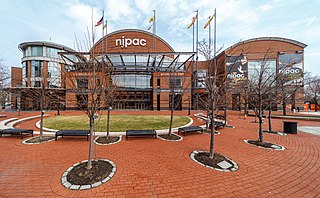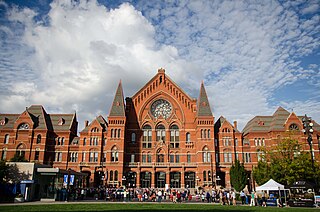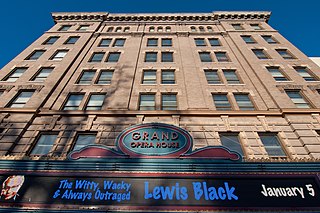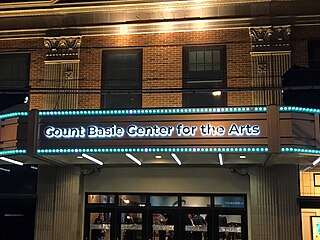
The New Jersey Performing Arts Center (NJPAC), in Downtown Newark in Newark, New Jersey, is one of the largest performing arts centers in the United States. Home to the New Jersey Symphony Orchestra (NJSO), more than nine million visitors have visited the center since it opened in October 1997 on the site of the former Military Park Hotel.

The Cowles Center for Dance and the Performing Arts is a performing arts center and flagship for dance in downtown Minneapolis, Minnesota, United States. The Cowles Center was developed as an incubation project by Artspace Projects, Inc and includes the refurbished 500-seat Goodale Theater ; the Hennepin Center for the Arts, home to 20 leading dance and performing arts organizations; a state-of-the-art education studio housing a distance learning program; and an atrium connecting the buildings. The Cowles Center is a catalyst for the creation, presentation and education of dance in the Twin Cities.

Music Hall, commonly known as Cincinnati Music Hall, is a classical music performance hall in Cincinnati, Ohio, completed in 1878. It serves as the home for the Cincinnati Ballet, Cincinnati Symphony Orchestra, Cincinnati Opera, May Festival Chorus, and the Cincinnati Pops Orchestra. In January 1975, it was recognized as a National Historic Landmark by the U.S. Department of the Interior for its distinctive Venetian Gothic architecture. The building was designed with a dual purpose – to house musical activities in its central auditorium and industrial exhibitions in its side wings. It is located at 1241 Elm Street, across from the historic Washington Park in Over-the-Rhine, minutes from the center of the downtown area.

The National Centre for the Performing Arts (NCPA) is a multi-venue, multi-purpose cultural centre in Mumbai, India, which aims to promote and preserve India's heritage of music, dance, theatre, film, literature and photography. It also presents new and innovative work in the performing arts field.

The Grand Opera House, often called The Grand and originally known as the Academy of Music, is a historic opera house located in Macon, Georgia, United States. Listed on the National Register of Historic Places in 1970, it is now the performing arts center of Mercer University.

Boller Brothers, often written Boller Bros., was an architectural firm based in Kansas City, Missouri which specialized in theater design in the Midwestern United States during the first half of the 20th century. Carl Heinrich Boller (1868–1946) and Robert Otto Boller (1887–1962) are credited with the design of almost 100 classic theaters ranging from small vaudeville venues to grand movie palaces.

The Count Basie Center for the Arts, originally Count Basie Theatre, is a landmarked performing arts center in Red Bank, New Jersey.

The Orpheum Theatre, a 2,308-seat venue listed on the National Register of Historic Places, is located in downtown Memphis, Tennessee, on the southwest corner of the intersection of South Main and Beale streets. The Orpheum, along with the Halloran Centre for Performing Arts & Education, compose the Orpheum Theatre Group, a community-supported nonprofit corporation that operates and maintains the venues and presents education programs.

Heinz Hall is a performing arts center and concert hall located at 600 Penn Avenue in the Cultural District of Pittsburgh, Pennsylvania. Home to the Pittsburgh Symphony Orchestra (PSO) and the Pittsburgh Youth Symphony Orchestra, the 2,676 seat hall presents about 200 performances each year. Originally built in 1927 as Loew's Penn Theatre, the former movie palace was renovated and reopened as Heinz Hall in 1971.

The Victory Theatre is a 1,950-seat venue in Evansville, Indiana. It is home to the Evansville Philharmonic Orchestra and also hosts local ballet and modern dance companies, theatre companies, and touring productions.

The Missouri Theatre, is a concert and entertainment venue in downtown Columbia, Missouri, occupying most of a city block between 9th street between Locust and Elm Streets. It was designed after the Opéra Garnier by the Boller Brothers, built in 1928, and is on the National Register of Historic Places. It is Columbia's only surviving pre-Depression movie palace and vaudeville stage. In 2011, the University of Missouri began a three-year lease of the facility. The Missouri Theatre is the resident home of the Missouri Symphony Orchestra, and is also frequently used by University of Missouri and civic groups. As of July 1, 2014, The University of Missouri took over ownership of the Missouri Theatre. It is one of the main performance venues for the University of Missouri School of Music.

Veterans Memorial Auditorium is a performing arts theater in Providence, Rhode Island. Construction began in 1928 but was delayed by the Great Depression. The theater was finally completed in 1950.

An atmospheric theatre is a type of movie palace design which was popular in the late 1920s. Atmospheric theatres were designed and decorated to evoke the feeling of a particular time and place for patrons, through the use of projectors, architectural elements and ornamentation that evoked a sense of being outdoors. This was intended to make the patron a more active participant in the setting.

The Victoria Theatre is a historic 1,154-seat performing arts venue located in downtown Dayton, Ohio. The Victoria hosts a variety of events including theatre, music, dance, film, and comedy.

Miller Symphony Hall is a 1,100-seat performing arts facility in Allentown, Pennsylvania that hosts the Allentown Symphony Orchestra. The hall was previously known as Central Market (1896), Lyric Theater (1899), and Allentown Symphony Hall (1959). In 2012, it was renamed for the Miller family, longtime owners of the hall and of The Morning Call newspaper.

The Colonial Theater is a historic theater in Idaho Falls, Idaho, founded in 1919 as a venue for live performances. From 1929 until 1990, it operated as a movie theater under the name The Paramount Theater. In the 1990s, the theater was renovated, and its original name was restored. It is currently part of the Willard Arts Center arts complex, owned and operated by the Idaho Falls Art Council.

The Mahalia Jackson Theater of the Performing Arts is a theater located in Louis Armstrong Park in New Orleans, Louisiana. It was named after gospel singer Mahalia Jackson, who was born in New Orleans. The theater reopened in January 2009, after being closed since the landfall of Hurricane Katrina.

The Victory Theatre is a theater in Holyoke, Massachusetts. It was built in 1919 and opened in 1920 by the Goldstein Brothers Amusement Company. The architecture is in the Art Deco style and is considered the last of its type between Boston and Albany. The Victory, a 1,600 seat Broadway-style theater has been derelict since 1979. Bought by Massachusetts International Festival of the Arts (MIFA) in 2009, the Victory will be returned by MIFA, to its role as a major performing arts center for the entire region. Fundraising for the 61 million dollar project continues through private, individual, corporate, and foundation donations, public grants, and State and Federal Historic Tax Credits and New Market Tax Credits. Recently the City of Holyoke made a 2 Million commitment in American Rescue Plan Act (ARPA) funds to the Victory and that the project anticipates funding of $3.5 Million to be allocated to build on these city funds through Governor Healey's capital spending plan.

The Mississippi Lofts and Adler Theatre is an apartment building and theater complex located in downtown Davenport, Iowa, United States. It is individually listed on the National Register of Historic Places by its original name, the Hotel Mississippi and RKO Orpheum Theater. The Hotel Mississippi was listed on the Davenport Register of Historic Properties in 2005. In 2020 the complex was included as a contributing property in the Davenport Downtown Commercial Historic District.

The historic Capitol Theatre was built at 50 West 200 South in Downtown Salt Lake City during 1913. Originally operated as a vaudeville house named Orpheum Theater, this was soon renamed Capitol Theater during 1927. And is currently also known as the JQ Lawson Capitol Theater. And this building style is Italian Renaissance and Mannerist architecture.





















